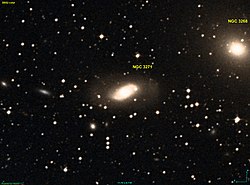| NGC 3271 | |
|---|---|
 DSS image of NGC 3271 | |
| Observation data (J2000 epoch) | |
| Constellation | Antlia |
| Right ascension | 10h 30m 26.49s[1] |
| Declination | −35° 21′ 34.2″[1] |
| Redshift | 0.012544[2] |
| Heliocentric radial velocity | 3737 ± 27 km/s[2] |
| Distance | 170.8 Mly (52.37 Mpc)[3] |
| Apparent magnitude (V) | 11.73[2] |
| Apparent magnitude (B) | 12.72[2] |
| Characteristics | |
| Type | SB00(r)[1] |
| Other designations | |
| IC 2585, MCG -06-23-044, PGC 30988[2] | |
NGC 3271 is a barred lenticular galaxy[1] in the constellation Antlia.[4] At magnitude 11.7, it is the brightest galaxy in the Antlia Cluster, which lies about 40.7 megaparsecs (132.7 million light-years) away.[5] It was discovered on May 1, 1834 by the astronomer John Herschel.[6]
References
[edit]- ^ a b c d "Results for object NGC 3271 (NGC 3271)". NASA/IPAC Extragalactic Database. California Institute of Technology. Retrieved 2021-02-19.
- ^ a b c d e "NGC 3271". SIMBAD. Centre de données astronomiques de Strasbourg. Retrieved 2021-02-19.
- ^ Crook, Aidan C.; Huchra, John P.; Martimbeau, Nathalie; Masters, Karen L.; Jarrett, Tom; Macri, Lucas M. (2007). "Groups of Galaxies in the Two Micron All Sky Redshift Survey". The Astrophysical Journal. 655 (2): 790–813. arXiv:astro-ph/0610732. Bibcode:2007ApJ...655..790C. doi:10.1086/510201. S2CID 11672751.
- ^ Dunlop, Storm (2005). Atlas of the Night Sky. Collins. ISBN 978-0-00-717223-8.
- ^ Dirsch, B.; Richtler, T.; Bassino, L. P. (September 2003). "The globular cluster systems of NGC 3258 and NGC 3268 in the Antlia cluster" (PDF). Astronomy and Astrophysics. 408 (3): 929–939. arXiv:astro-ph/0307200. Bibcode:2003A&A...408..929D. doi:10.1051/0004-6361:20031027. S2CID 763415. Retrieved March 10, 2012.
- ^ Seligman, Courtney. "New General Catalogue objects: NGC 3250 - 3299". cseligman.com. Retrieved 2021-02-19.
Well, that’s interesting to know that Psilotum nudum are known as whisk ferns. Psilotum nudum is the commoner species of the two. While the P. flaccidum is a rare species and is found in the tropical islands. Both the species are usually epiphytic in habit and grow upon tree ferns. These species may also be terrestrial and grow in humus or in the crevices of the rocks.
View the detailed Guide of Psilotum nudum: Detailed Study Of Psilotum Nudum (Whisk Fern), Classification, Anatomy, Reproduction